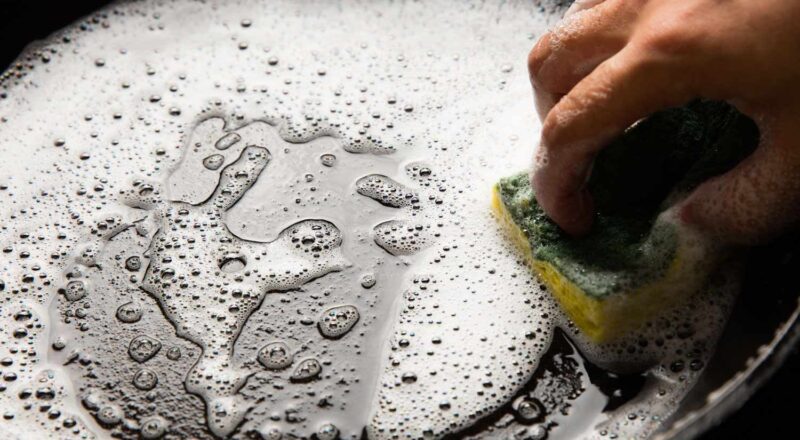When setting up a modern kitchen, many people wonder why can’t you use cast iron on a glass top stove. Glass top stoves have become popular due to their sleek, smooth surfaces, which lend a contemporary look to any kitchen. But using cast iron cookware on a glass top stove may come with certain risks. In this article, we’ll explore these risks and provide comprehensive insights to help you make an informed decision.

Understanding Glass Top Stoves
How Do Glass Top Stoves Work?
Glass top stoves, also known as ceramic cooktops, operate with either electric or induction heating elements located beneath the glass surface. This design ensures uniform heat distribution and a sleek, easy-to-clean surface. However, the glass surface can be both a strength and a limitation, particularly when it comes to using certain types of cookware.
The Beauty and Challenges of Glass Top Stoves
Glass top stoves have numerous advantages, from a minimalist aesthetic to easier maintenance. On the flip side, their delicate surface is susceptible to scratches, cracks, and other damage, influencing the types of cookware that are compatible with them.

The Charm of Cast Iron Cookware
Benefits of Using Cast Iron
Cast iron cookware is highly valued for its durability, superior heat retention, and even cooking. Many home chefs adore their seasoned cast iron skillets because they can last a lifetime with proper care.
Why Cast Iron is a Kitchen Favorite
One reason cast iron is beloved in kitchens everywhere is for its versatility. A single cast iron skillet can go from the stovetop to the oven, making it ideal for recipes requiring different cooking methods. From frying up crispy hash browns to cooking a mouth-watering pot roast, cast iron is a staple for many.
To learn how to cook hash browns effectively, check out this [link](https://howtocleancastiron.com/how-to-cook-hash-browns-in-cast-iron-skillet/) hash browns recipe.

Why Glass Top Stoves and Cast Iron Don’t Mix
1. Risk of Scratching the Glass
Cast iron cookware often has a rough and uneven bottom that can easily scratch the smooth surface of a glass top stove. Once these scratches appear, they can be challenging to remove and may compromise the efficiency and longevity of your stove.
2. Weight Issues
Cast iron cookware is notorious for being heavy. The significant weight, particularly when filled with food, can strain the glass top, leading to potential cracks or even breakage.
3. Uneven Bottoms
Unlike other cookware types, cast iron often comes with slightly uneven bottoms. These inconsistencies can create hotspots and uneven cooking, challenging the glass top stoves uniform heat distribution.
4. Thermal Shock
Glass top stoves are sensitive to rapid temperature changes. When hot cast iron cookware is placed on a cold glass top, it can cause thermal shock, potentially cracking or damaging the glass surface.

Caring for Your Glass Top Stove
Daily Maintenance
To keep your glass top stove in pristine condition, daily maintenance is key. Wipe down the stove after each use to prevent food particles from scratching the surface.
Handling Stubborn Stains
If stubborn stains or burnt-on food persist, use a specialized cleaner designed for glass tops to avoid damaging the surface. Avoid using abrasive pads that can scratch the glass.
Inspecting for Damage
Regularly inspect your stove for any scratches or cracks. Early detection can prevent minor issues from escalating into major problems.
Alternative Cookware for Glass Top Stoves
Recommended Materials
If you must move away from cast iron, consider cookware made of stainless steel, aluminum, or porcelain. These materials provide effective cooking without harming your stove.
Best Practices for Alternative Cookware
Ensure that any alternative cookware you choose has a smooth, flat bottom to maximize contact and heat distribution on the glass top stove.
Cooking Tips & Tricks
Recipes for Your New Cookware
While its a tough decision to part from cast iron, switching to compatible cookware can still bring joy to your culinary adventures. Explore some delicious recipes to test in your new setup here.
Safe Use of Cast Iron on Glass Top Stoves
Precautions
If you can’t part with your cast iron, take these precautions: lift rather than drag the cookware to avoid scratches, and always use a protective barrier like a paper towel or silicone mat between the cast iron and the glass surface.
Assessing Your Risks
It’s essential to weigh the risks of using cast iron on a glass top stove. While some manage to use cast iron successfully, it’s often a gamble with high stakes for your expensive glass top stove.
FAQs About Glass Top Stoves and Cast Iron Cookware
1. Can I Season My Cast Iron on a Glass Top Stove?
No, seasoning your cast iron should ideally be done in the oven to ensure even heat distribution. Using a stove can create hotspots and uneven seasoning.
2. Whats the Best Way to Clean Cast Iron Cookware?
Hand wash your cast iron with warm water and a non-abrasive brush. Avoid using dish soap or a dishwasher, which can strip the seasoning.
3. Are There Any Other Cookware Types I Should Avoid on a Glass Top Stove?
Avoid using ceramic cookware with rough bases or any cookware with warping or deformations that can scratch or damage the surface.
Conclusion
Understanding why you can’t use cast iron on a glass top stove is crucial for maintaining both your cookware and stove’s longevity. While parting with your beloved cast iron may seem daunting, embracing the right alternatives ensures your kitchen remains functional and efficient. Enjoy the culinary adventure safely and smartly!
As an Amazon Associate, I earn from qualifying purchases.

